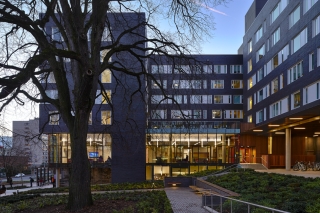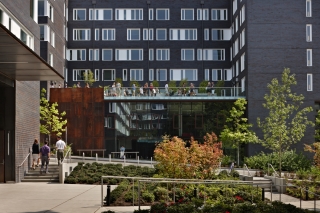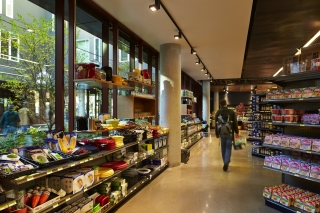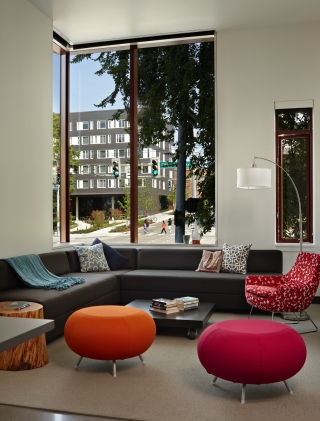|
Subscribe / Renew |
|
|
Contact Us |
|
| ► Subscribe to our Free Weekly Newsletter | |
| home | Welcome, sign in or click here to subscribe. | login |
Architecture & Engineering
| |
July 10, 2013
Project of the Month: UW's new dorms show off their street smarts
Special to the Journal
A new neighborhood is rising at the University of Washington, and it isn't on the historic campus. By design, it's part of the city.
This is the first of a three-phase extension of the UW called West Campus. Three halls — Poplar, Elm and Alder — and Cedar Apartments cover much of three separate blocks near the intersection of Brooklyn Avenue Northeast and Northeast Campus Parkway.
In many ways, the units inside are typical of student housing, but outside these buildings don't read “dormitory.”
One reason for this is urban design. They are built to the edge of the streets. Walls and entrances meet sidewalks as in any urban mixed-use building. Residential units are on the upper levels, and ground floors are dominated by shared uses and open space. Courtyards are welcoming and accessible to the public much of the time.
All this blurs the boundaries between the campus — where students traditionally live and go to classes — and the rest of the city. You can't really tell where either begins.
Open the gates
“It's not the ivy-covered walls and the closed gates,” said architect Anne Schopf. “It's a more porous university, a nimble university.”
With this project, the institution is testing a new model for publicly held land that coexists with other uses in the city, according to University Landscape Architect Kristine Kenney.
It's an experiment that's working. The corner store, for instance, looks like any upscale urban grocer, and the public is welcome to shop. But it's operated by the University of Washington's housing and food services arm, which also runs the rest of the complex.
In addition to the 7,000-square-foot grocery store, there's a cafe, conference center, academic support center, health and wellness center, and two retail spaces.
Public open spaces beckon from Northeast Campus Parkway. They include a small park cut into one of the blocks. At the center, branching over all, is a 100-year-old elm that once stood in a parking lot. Now it's the green heart of a neighborhood.
All of this ties in with changes in the surrounding streetscape that welcome pedestrians to a stretch of Northeast Campus Parkway that had been neglected for decades. On blocks around the student housing, roadways have been narrowed and sidewalks widened. Street trees have been planted and covered bus stops have been added.
The project had a very constrained budget so even though zoning would allow more height, the buildings are modest seven-story structures, with traditional “five-over-two” construction. Three are rated LEED gold; one is silver.
But they all are very modern in attitude. Simple volumes are carved out to allow open space and admit sunlight deep into the lower floor plates. Shared spaces like kitchens, lounges and study areas adjoin these light-filled areas.
Avoiding the dorm look
Another reason the buildings cannot be typecast is the windows. They don't appear to be in a regimented grid, like other mid-rise apartment buildings with repetitive floor plans.
And that's no easy feat. “The problem with student housing is that there is no variation in room size,” said Schopf. “It can become very institutional, very quickly.”
Given the tight budget, varying room plans for interest was not an option. Instead, the spacing of stock vinyl windows is visually shuffled in a custom system that defies the usual “punched window” look.
Windows themselves are set within longer horizontal openings in the dark brick walls, disbursed with white aluminum panels that blend with the framing. Some of these openings wrap building corners. So the impression is not one of stock vinyl punched windows, but of a uniquely modern window system.
After the window system, it's the material palette that lifts the project out of the typecast dormitory role.
The bricks have a manganese-containing flash or coating that makes them subtly reflective and distinguishes the complex from the brick of the historic campus. Curtainwall is judiciously used on the ground level and the second floor.
The most arresting material is weathering steel. With their ferrous patina, large panels are artfully perforated in abstracted cloud patterns. Used outside and in, the rust forms an uneven protective coating that can be easily marked on — and just as easily erased by brushing. Along the street, the panels hide a myriad of intakes and exhaust louvers which would otherwise mar the view at street level.
If demand is any indication, the project is successful. It has been oversubscribed since opening last fall. In mid-summer, the cafe is full, and shoppers peruse the artfully laid out produce in the grocery. It's hard to tell if they are students or workers from a startup business in the U District. And that's the idea. It's all part of the neighborhood.
Jury comments:
“The project manages to make a marriage of density and open space without compromising aesthetic detailing.” “The window alignments and exposure are examples of holding a parity between utility and design. (Materials) read as a nod to the nostalgia of blackboards and learning.”
| West Campus Housing Phase I |
|
Cedar Apartments: 1112 and 1128 N.E. 41st St. Poplar Hall: 1302 N.E. Campus Parkway Elm Hall: 1218 N.E. Campus Parkway Alder Hall: 1315 N.E. Campus Parkway Architect: Mahlum Architects Anne Schopf , Mark Cork, Gerald (Butch) Reifert, Maureen O'Leary, Dwayne Epp, David Swenson, Brian Jonas, Wes Hoffman, Christopher Lamb, Kurt Haapala, Bryan Fish, Joseph Mayo, Brian Frey, Erol Taner, Jeanelle Owens, Stacey Bender, Amy Evans-Noe, Masumi Saito, Caitlin Kruse, Robert Lecher, Pierce McVey, Vince Gonzales, JoAnn Wilcox, PJ Bauser, Susan Fore, Eugene Lau, Stephen Jones, Erica Hildebrand, Michael Weller, Rene Fresquez, Rachel Minnery Owner: University of Washington (Housing and Food Services) Project type: Student housing Size: 2.87 acres (four building sites) 668,800 square feet (in four buildings) Completion: September of 2011 (Cedar Apartments and Poplar Hall) September of 2012 (Alder and Elm Halls) Construction cost: $118.8 million Landscape architect: Gustafson Guthrie Nichol Civil engineer: SvR Design Co. Structural engineer: Coughlin Porter Lundeen Mechanical and electrical engineer: PAE Consulting Engineers Acoustical designer: SSA Acoustics Telecommunications consultant: AEI Affiliated Engineers Environmental graphics: Square Root Food market design: Phillips Enterprises Kitchen consultant: JLR Design Group General contractors: Walsh Construction Co. (Poplar and Alder halls) W.G. Clark Construction Co. (Cedar Apartments and Elm Hall) |
The Project of the Month is sponsored by the Daily Journal of Commerce and the Seattle chapter of the American Institute of Architects. The Project of the Month was selected with the assistance of architect Jane Hendricks, artist Mary Ann Peters, and developer Chris Rogers. For information about submitting projects, contact Joan Hermann at AIA Seattle at joanh@aiaseattle.org.
Clair Enlow can be reached by e-mail at clair@clairenlow.com.
Previous columns:
- Project of the Month: Brightwater: a model for art, education and infrastructure, 06-12-2013
- Project of the Month: 'Mad Men'-era high school now works for millennials, 05-01-2013
- Project of the Month: Q Nightclub: ‘Shock and awe’ design for grungy Seattle, 04-10-2013
- Project of the Month: ‘Question everything': Federal Way cuts school costs — a lot, 03-13-2013
- Project of the Month: OKA's [storefront]: An experiment becomes essential, 02-06-2013
- Project of the Month: Exceptional design calms the chaos of a student fitness center, 12-05-2012
- Project of the Month: Greenbridge in White Center has a kid-friendly heart, 11-07-2012
- Project of the Month: Suburban school with a Zen garden at its heart, 10-03-2012






